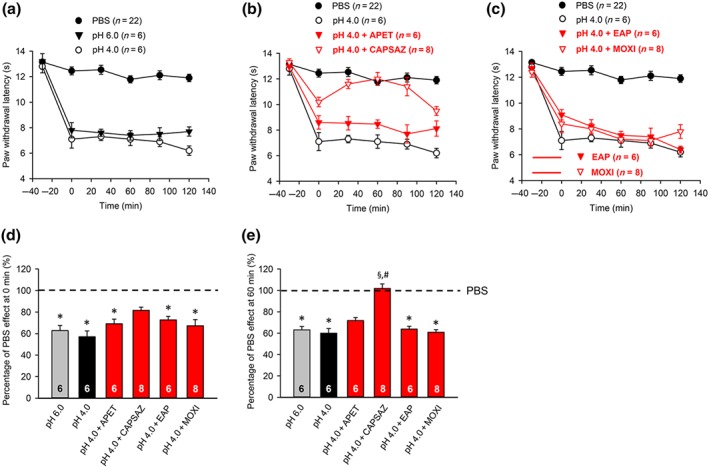Figure 2.

Modulation by pharmacological antagonists and acupuncture family procedures of acute thermal hypersensitivity caused by local acidification to pH 4.0. At −30 min, pH 4.0 PBS alone, or alternatively capsazepine (10 μM), or APETx2 (20 μM) dissolved in pH 4.0 PBS, was injected to the left hind paw of rats; in another series of experiments, EAP or moxibustion, both for 30 min, was delivered to the Zusanli acupoint (ST36) of rats at the ipsilateral side, again after injecting pH 4.0 PBS. PWL measurement was as in Figure 1. Thirty four rats were used to generate the data presented below. (a–c) The time‐dependent effects of pH 6.0 and pH 4.0 PBS are shown alone (a), as well as the effects of pH 4.0 PBS together with APETx2 (20 μM), capsazepine (10 μM) (b), EAP, or moxibustion (c) on the acidification‐induced decrease of PWL. For comparison, the change in PWL measured after injection of pH 7.4 PBS injection was plotted at each time point. Mean ± SEM determined on the bracketed number of animals. (d,e) Effects of pH 4.0 PBS, and APETx2 (20 μM), capsazepine (10 μM), EAP, or moxibustion determined in pH 4.0 PBS, expressed as a percentage of the normal PBS (pH 7.4; 100%) effect at 0 min (d) or 60 min (e). Mean ± SEM of the indicated number of experiments. * P < .05, significantly different from the mean PWL measured after PBS (pH 7.4) injection at 0 min (d) and at 60 min respectively. § P < .05, significantly different from the effect of pH 4.0 PBS injection at 60 min; Kruskal–Wallis one‐way ANOVA on ranks (D,H = 50,290; E,H = 50,223) followed by Dunn's test. # P < .05, significantly different from the effect of pH 4.0 PBS injection at 0 min (d) or 60 min (e); two‐way ANOVA (Ftreatment = 18.784, Ftime × treatment = 3.615) followed by Dunn's test
